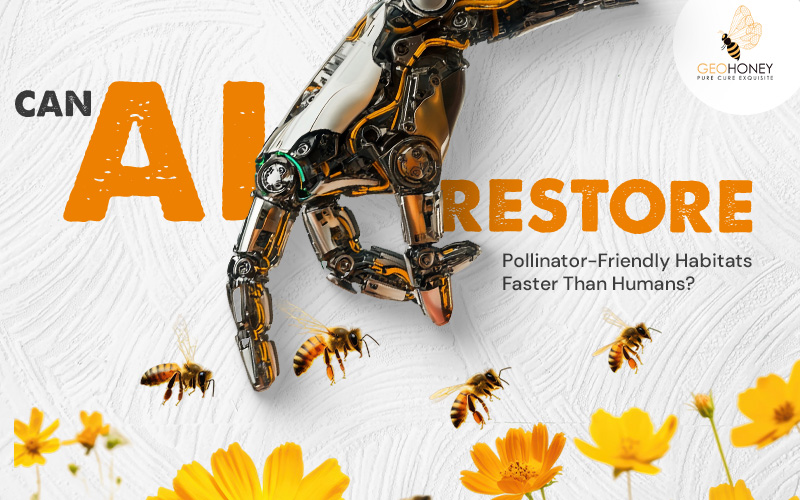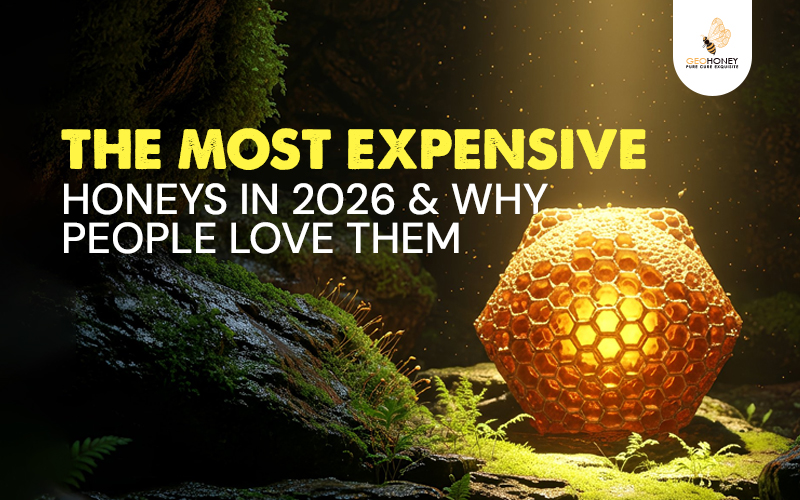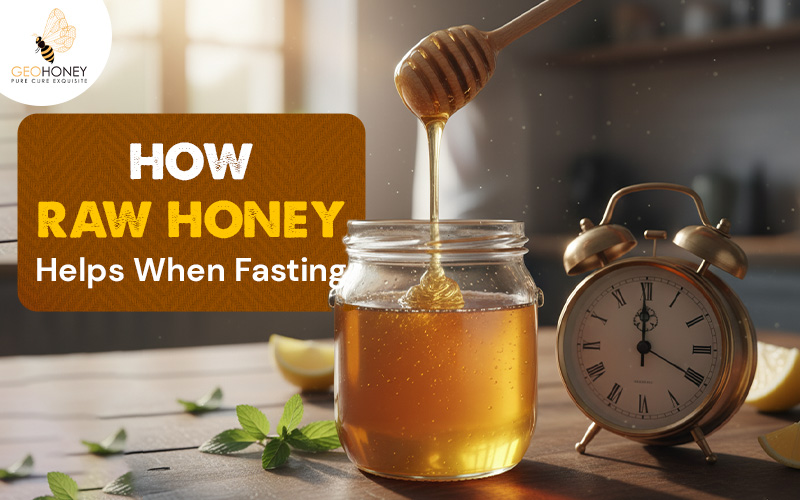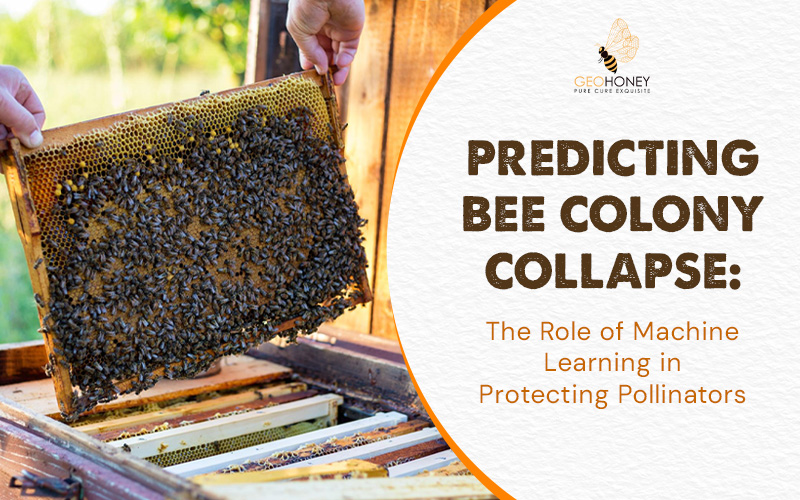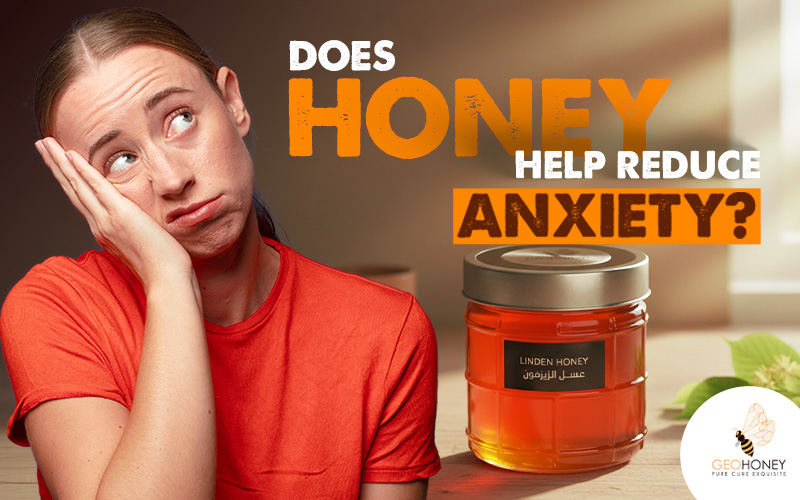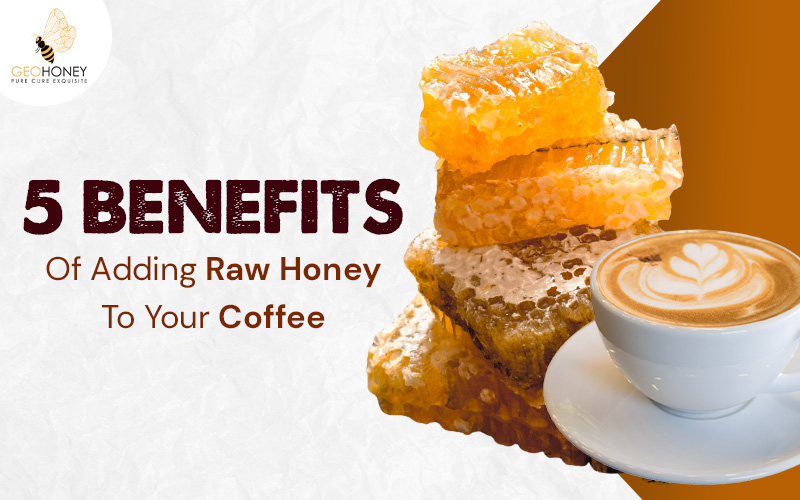- Tokyo: 17:11
- Singapore: 16:11
- Dubai: 12:11
- London: 08:11
- New York: 03:11
Our Blogs
Geohoney
Why Yemen is Known as the Home of Sidr Honey
The Sidr honey from Yemen is popular among honey enthusiasts globally as it possesses a unique set of features. This honey is a symbol of the region’s rich beekeeping heritage.
The resilient Sidr tree or Ziziphus spina-christi tree provides the nectar for this honey. This tree thrives in Yemen’s arid mountainous regions away from pollution or human influence.
Yemen is a country with a rich beekeeping tradition, and that is why many people label it as the home of authentic Sidr honey.
This blog discusses what makes Yemen a key player in the production of this organic honey. So, keep on reading to learn more.
Sidr Honey: Origins and Key Features
Sidr Honey from Yemen: What Makes it A Perfect Home for This Exotic Honey
Cultural Significance of the Yemeni Sidr Tree
Abundance of Sidr Trees in Pristine, Natural Habitats
Ancient Beekeeping Traditions Still in Practice
Limited Production
Health Benefits
Sidr Honey: Origins and Key Features
Sidr honey originates from the Ziziphus spina-christi tree, also referred to as the Sidr tree. This tree is indigenous to the remote mountainous locations of Yemen, including places like Wadi Do'an (Hadramaut), Al-Osaimat, and Shabwa. Sidr trees grow in pristine environments that contribute to the high purity of the honey.
A recent report by the World Bank says that the honey production in recent years has been estimated at roughly 2,500–3,000 tons annually in Yemen.
Sidr trees are very resilient and drought-tolerant, which makes the arid mountains and valleys of Yemen suitable for their growth.
Because of this unique nectar source, this raw honey possesses a unique set of characteristics. Here are a few notable ones.
Sidr honey has a rich, earthy, and caramel-like flavor.
The texture of this honey is thick and velvety.
This honey possesses a dark amber to golden color.
The slow rate of crystallization imparts a long shelf life to this honey.
Sidr Honey from Yemen: What Makes it A Perfect Home for This Exotic Honey
The following points illustrate why Yemen is the home to the pure, exotic Sidr honey.
Cultural Significance of the Yemeni Sidr Tree
The source of the Sidr honey is the Sidr tree which is a symbol of blessing as well as healing in the local tradition. Several Islamic texts associate this tree with divine purity and protection.
The fruit, bark, and leaves of this tree find uses in traditional medicine for skin and hair care. Several remedies with these ingredients are also a part of ancient cultural rituals in the area.
The deep cultural respect that this tree enjoys is the reason why it stands tall as Yemen’s most prized natural asset.
Abundance of Sidr Trees in Pristine, Natural Habitats
Yemen possesses a diverse geography. It has high mountains and deep valleys. You can also find dense forests and vast deserts in the region. The region’s unique location and climate provide ideal conditions for the Sidr trees to grow in abundance.
Several regions throughout Yemen support the growth of these trees. Most common examples include the following.
Wadi Do’an in Hadhramaut (known for its unique Sidr honey doani)
Shabwa
Amran
Dhamar
Marib
The sidr trees have deep roots and high resilience against harsh climates. This makes Yemen’s semi-desert environments ideal for these trees. Bees that feed on the nectar from these trees produce pure Sidr honey that is free from any adulteration whatsoever.
Apart from pristine climate, other factors like the clean air and mineral-rich soil also play a vital role in the growth of Sidr trees that contain high concentrations of pure nectar that bees use to create the iconic Sidr honey.
Ancient Beekeeping Traditions Still in Practice
Yemen is the home of pure sidr honey, as the local beekeepers still rely on ancient techniques for harvesting as well as processing this liquid gold.
Research shows that more than 100,000 Yemeni beekeepers rely on honey production as a key livelihood.
The wild Sidr trees grow in the region without any pesticide usage. Most beekeeper prefers to harvest by hand. The minimal use of machinery ensures unparalleled purity of this honey.
These beekeepers do not heat or pasteurize this honey. There is also minimal filtration which allows the honey to retain most of its nutrients.
Another ancient method that Yemeni beekeepers use is the seasonal hive migration. These experts use their insights into flowering cycles as well as weather patterns to discover blooming Sidr trees. Then they shift their hives to these regions, which ensures maximum nectar collection.
These ancient beekeeping practices create a very special honey that you only find in Yemen and nowhere else in the world.
Limited Production
Unlike regular honey, the honey from Yemen is not that abundant. The Sidr tree blooms only twice a year for just a few weeks. This limits the nectar availability.
To get the honey, local beekeepers have to travel to remote hives in mountainous regions. The difficult harvesting conditions also limit the availability of this honey.
After the harvest, these beekeepers use traditional processing methods that focus more on purity and less on the yield. All these factors lead to very limited production of this honey.
Health Benefits
Yemeni honey is rich in nutrients, including
Phenolic Acids
Flavonoids
B Vitamins
Iron
Calcium
Potassium
Zinc
Mangesium
Glucose Oxidase
These healthy components impart antibacterial/anti-inflammatory effects to this honey. It enhances immunity and destroys pathogens that can prove harmful to your health. Regular use of this honey promotes digestive health.
This honey is a key part of traditional Yemeni remedies for seasonal illnesses as well as wound healing. Topical use of this honey also promotes skin health. Sidr honey before bed induces calmness, which leads to better sleep.
Conclusion
Every single batch of Yemeni Sidr honey encapsulates purity and centuries of tradition. Yemen’s unique natural environment along with the meticulous craftsmanship of the local beekeepers, makes it the home of pure Sidr Honey.
Honey lovers from around the globe cherish this product for its unmatched flavor. The rarity as well as impressive healing features further make this specific honey so popular. So if you wish to see firsthand what makes Yemen a perfect region for Sidr honey production, make sure to try this exotic honey at least once in your lifetime.
Visit us at Geohoney today to buy premium quality, authentic Yemeni Sidr honey that has no match for its purity and exquisite flavor.
FAQs
What makes Yemen’s geography perfect for Sidr trees?
The region is popular for its distinctive wilderness. Yemen’s rich landscapes span from coastlines to mountains. The region also has pollution-free highlands as well as valleys that support the growth of pristine Sidr trees.
What is the reason behind the high price of Yemeni Sidr honey?
The Sidr tree blooms only once or twice a year for a very short time. This leads to a limited supply of the nectar for Sidr honey. The limited production with high demand drives the high prices of this honey.
What are some other common names of Sidr trees?
This tree is also known as the Lote tree or Christ's Thorn. People also refer to it as the Jujube or Nabkh tree based on their local customs.
What are the special features of Sidr honey that set it apart?
Yemeni honey comes from Sidr trees that grow in pristine forests. This honey is minimally processed with the help of ancient beekeeping tools and methods, which leads to its distinct flavor.
Is Sidr honey healthier than Manuka honey?
Sidr honey possesses a rich flavor with a smooth texture. This honey also has potent healing features due to its high antioxidant content.
Manuka honey, on the other hand, possesses strong antibacterial properties due to high MGO content. Thus, both of these honey types are equally beneficial in terms of their nutritional value.
Is Sidr honey exclusively from Yemen?
This honey comes from the nectar of the sidr tree (Ziziphus spina-Christi). This tree is native to some parts of Saudi Arabia and Yemen.
Geohoney
Can AI Restore Pollinator-Friendly Habitats Faster Than Humans?
Pollinator habitats are rapidly shrinking due to climate change, urban expansion, increased pesticide use, and land-use changes. Consequently, the world is turning to AI to solve the problem. The big question is, “Can artificial intelligence help rebuild these habitats faster and more efficiently than human-led efforts?” Early comments suggest that while AI can speed up mapping, restoration planning, and plant selection, it cannot fully replace human expertise, field experience, or ecological understanding. This blog explores where AI excels, where it falls short, and how humans and AI can work together. Below are a few recent statistics that record the reliance and decline of pollinator species: More than 87% of flowering plant species and 87% of the leading global food crops rely on pollinators for seed production. 40% of invertebrate pollinators, including bees and butterflies, are at risk of extinction. Primary drivers of pollinator decline are habitat loss and changes in land use. These changes reduce the availability of nesting spots and resources. Moreover, it reduces the abundance and variety of flowering plants and trees, in turn reducing the availability of pollen. Climate change further alters the timing of pollinator emergence. It affects the onset and duration of flowering, creating a mismatch between plants and their pollinators. Changes in water levels and temperature can affect how plants look and smell, two key traits that attract pollinators. When water is limited or temperatures rise, plants often produce fewer flowers, and the flowers themselves tend to be smaller. This reduces the plant’s overall floral display and makes it less appealing to pollinators. Human land mapping and habitat assessment often take weeks of field visits, soil testing, and expert observations. AI can speed this up significantly by: Analyze satellite images to identify degraded areas. Spotting patterns of soil degradation, erosion, and vegetation loss. Classifying land cover types with high accuracy. Predict which zones are best for pollinator habitats and which ones are at risk. Machine learning models can perform this process repeatedly across thousands of acres. This is nearly impossible for human teams to match within the same timeframe. It matters because restoration projects depend on all this data and often stall when teams lack clear visibility into where to start. Plant selection is crucial for restoring pollinator-friendly habitats. The wrong species fail to attract pollinators and even disrupt local ecosystems. Artificial intelligence can analyze the following aspects: Local climate data Flowering cycles Soil composition Pollinator migration patterns Long-term climate predictions Using all this data, AI can suggest plant combinations to attract and support different pollinators, such as bees, butterflies, beetles, and even nectar-eating birds. Once habitats are restored, they require ongoing monitoring to maintain their health. While it may be challenging for humans to track minute changes and identify patterns until they become significant, AI sensors, drones, and computer vision can do so more quickly. They’re equipped to: Track plant growth Count pollinator visits Pick the early signs of diseases Identify irrigation needs Monitor pesticide drift Spot harmful weeds and more With these real-time inputs, human teams can intervene quickly before problems escalate. Pollinator habitats today are susceptible to shifting rainfall patterns, temperature spikes, and drought. Data-trained AI models can predict: Expected temperature patterns Rainfall trends Variation in seasons Probabilities of extreme weather changes This data helps teams design habitats that can withstand future conditions, leading to higher survival rates, fewer failed plantations, and faster long-term restoration. There are various examples of robotic pollinators today. For instance, Robot bees for pollinating high-value specialty crops. They perform the same activity as a blood and fresh pollinator, achieving precision while mitigating factors that hinder pollination when left to nature. Another example is MIT’s robotic insects. These tiny flying robots mimic the movement of bees. They weigh less than a paperclip and use smart aerodynamics to fly, hover, and move with high precision. Since they can navigate tight spaces and work quickly, they can be used in both open habitats and vertical farms to support pollination. It is no surprise that AI has its own shortcomings. Any errors in the data that the AI gets trained on can lead to mistakes in analysis and interpretation. Here are a few areas where AI might fail: Misinterpret satellite data in complex terrains. Struggle with microclimatic changes and unpredictable natural events. May not be able to account for local, tribal, and cultural knowledge around the said land, plants, and pollinator species. Lacks intuition This gap confirms that AI is a tool and not a replacement for humans. AI can support their work, but cannot match human judgment or local ecological understanding. Therefore, the fastest and most effective model is a partnership: AI-guided design + human-led restoration. Task AI Strength Human Strength Mapping land for restoration Extremely fast data processing using satellite and drone imagery Detailed ground verification and contextual understanding Matching plant species Predictive models based on climate, soil, and pollinator needs Experience with local species, weather patterns, and ecological history Detecting threats Real-time monitoring using sensors and pattern recognition Sensitivity to on-ground changes and community impacts Actual planting and maintenance Cannot perform manual tasks Skilled planting, care, and long-term stewardship Long-term adaptation Learns patterns but lacks intuition Adapts to unpredictable ecological shiftsKey Insights To Know
Reasons Behind Loss of Pollinator-Friendly Habitats
How Can AI Help?
1. Land Mapping
2. Match Plants Based on Ecology and Climate Data
3. Detects Threat Early
4. Predicts Climate Risks and Improves Restoration Success Rates
Role of Robotic Pollinators
Areas Where AI Can Fail
AI vs. Humans: Who Restores Faster?
Geohoney
One Spoon a Day: 2026’s Biggest Honey Habit
As health trends turn simpler and more intuitive, more and more people are considering a single, delicious, daily habit in 2026. And that is one spoonful of honey a day. One spoonful of honey every day can be your biggest habit for 2026, and the credit goes to honey’s exceptional nutritional profile. This blog delves into the benefits of making a spoonful of organic honey every day a big part of your wellness routine in 2026. So, keep on reading till the end. Here are some key takeaways from this blog. One spoon of honey a day can be your biggest 2026 wellness habit due to its multifaceted benefits. Honey raises your blood sugar slowly, which sustains your energy levels. Honey’s antioxidant and anti-inflammatory features make it essential for your immune system’s health. You can drizzle raw honey over classic breakfast recipes. You can also mix it up with lemon, warm water, and tea. You can have raw honey directly every day for better health. Here is what you will find in this blog. One Spoonful of Honey a Day: Why It Is Effective Ways You Can Enjoy Your Daily Spoonful of Honey in 2026 You can take a spoonful of raw honey every single day in 2026 to enjoy several health benefits, and this is what this section is all about. Honey consists of simple sugars that the body metabolizes at a slow pace. The glucose in honey generates quick fuel to keep you active. On the other hand, the fructose content of honey processes more slowly in the body, which leads to a steady rise in your blood sugar. This slow rise further leads to a slower blood sugar crash, which is not common with refined sweeteners. Raw honey has polyphenols and flavonoids, which are important antioxidants for our system. This honey improves the health of your immune system and protects cells from the harmful effects of external oxidative stress. Honey helps in your fight against inflammation. It also strengthens your immunity against seasonal illnesses which ensures you enjoy great health all year round. Honey’s exceptional antioxidant content is the reason why most ancient and modern medicines use it as a key ingredient. Many types of honey have exceptional antibacterial and antimicrobial effects. These features make it a great addition to your everyday diet during flu season. Honey has essential minerals and vitamins B and C. These protect your body from internal and external threats, which is good for your immunity. Raw Honey has a huge positive impact on your sleep schedule, and that is also something that makes it a good habit for 2026. A spoonful of honey before bed stabilizes nighttime blood sugar. It also helps the brain produce melatonin, which is an essential sleep hormone. You can combine a spoonful of honey with warm herbal tea and sip a cup daily at night to get better, regular sleep. Pure Honey prevents several heart diseases as it lowers blood pressure and improves blood fat levels. It also regulates your heartbeat and prevents the death of healthy cells. Heart patients can use honey every day to manage their conditions and reduce the risks of strokes and seizures. Raw Honey is an extremely beneficial dietary addition for your gut health. It acts as a prebiotic, which means it feeds the good bacteria in your stomach. This prevents constipation and aids digestive processes. Many people who consume raw honey every single day have virtually no complaints of bloating and digestive discomfort. So add raw honey to your everyday diet in 2026 to enjoy a well-functioning gut for years to come. There are many ways you can add monofloral honey to your daily diet in 2026 to create this lasting healthy habit. And this is what the following section is all about. You can eat raw honey directly from the jar. Honey enters your bloodstream gently, which ensures your blood sugar doesn’t increase rapidly. You can add 1 tbsp raw honey in warm water and throw in the juice of half a lemon to the mix. You can use this combo for morning detoxification to get a healthy start to your day. Athletes or people who engage in physically demanding activities can take 1 spoon of honey and add a pinch of Himalayan salt to it. Then they can add a squeeze of lemon to this mixture to create a quick energy and electrolyte-rich pre-workout shot to keep them going for hours. You can visit us at Geohoney today to explore our wide range of honey varieties to successfully build your healthy honey-eating habit in 2026. You can take honey in moderation every day to enjoy a better immune system and heart health. It also stabilizes energy levels and regulates your blood sugar. You can add it to your coffee or tea. Another option is to drizzle it over your breakfast. You can also go with raw honey consumption. Honey comes with superior mineral and antioxidant content that make it a much better alternative to regular sugar. Honey comes with a low GI of about 50, which raises your blood sugar at a very low rate as compared to natural sweeteners. Raw honey before bed is what most people find effective. It stabilizes blood sugar and promotes better sleep, and that leads to stable energy levels throughout the day. One Spoonful of Honey a Day: Why It Is Effective
A Consistent Supply of Natural Energy
Comes with Antioxidants
Better Immune System Performance
Stable Sleeping Cycles
May improve heart health
Gut Health
Ways You Can Enjoy Your Daily Spoonful of Honey in 2026
Take a Spoonful of Raw Honey
Honey Lemon Combo
A Great Pre-Workout Ritual
FAQs
What happens if one consumes a spoonful of honey on a daily basis?
How can you consume honey daily?
Is honey a healthy alternative to regular sugar?
Does honey increase your blood sugar level rapidly?
Is honey good at night or in the morning?
Geohoney
2026 Honey Market Forecast: Prices, Demand & Big Shifts
Honey, or liquid gold as many call it, is heading into 2026 with substantial shifts in prices and demand. After long years of climate pressure, production fluctuation, changing consumer behavior, and other factors, honey is no longer "just" a sweetener. It is a strategic commodity. This article breaks down the 2026 forecast for honey, covering all you need to know: prices, demand, driving factors, and more. The global honey market is expected to grow from USD 9.73 billion in 2026 to USD 14.73 billion by 2035. The expected CAGR during this period is 4.7%. The honey industry has witnessed: 35% more investments in sustainable beekeeping practices 31% growth in e-commerce distribution 27% rise in the launch of flavored honey products As per the United Nations Conference on Trade and Development (UNCTAD), over 120 exporting countries are involved in global trade. Honey is recognized for its many benefits. For starters, it contains essential antioxidants and trace minerals and vitamins. Honey also boasts antibacterial, antimicrobial, and anti-inflammatory properties. These unique properties make it suitable for heart health, healing, weight management, and metabolism. Unlike sugar, its low glycemic index offers sustainable energy without glucose spikes. Thus, making it suitable for individuals with diabetes after careful consideration from doctors. One of the significant shifts brought about by rising health consciousness is the increasing demand for natural sweeteners. Raw honey, which is minimally processed and retains most of its natural enzymes and nutrients, is a great alternative here. Honey is an excellent skin-soothing and nourishing ingredient that finds its application in body lotions, moisturizers, face masks and even face washes. It helps reduce bacteria, intensely hydrates your skin, and speeds up the wound healing process. Furthermore, its results for even toning skin tone and treating acne, psoriasis, and eczema make it a sought-after ingredient. Functional foods are foods that are enhanced with specific nutrients that offer health benefits beyond just the basics. Honey is one such functional food. With over 200 components improving its medicinal and physiological properties, honey can be used in a variety of foods. These include: Biscuits Ice creams Breakfast items like shakes, oats, and toasts Breads and baked goods Sauces and marinades Its probiotic properties make it excellent for maintaining good gut health. This, in turn, improves overall metabolism and food absorption. The decline in bee colonies globally forced the farmers, environmentalists, and other stakeholders to make efforts using advanced AI, machine learning, and monitoring systems to protect bee colonies. The use of AI for hive monitoring has shown impressive results for improving colony health, preventing collapse and improving bee foraging. All these factors contribute to increased honey production by bees and harvest by farmers. We all know of honey varieties like Manuka, Oak, Acacia, etc. However, we are now seeing a rise in unique combinations that offer a deep flavor profile along with benefits. For instance: Turmeric honey for combating inflammation Ginger honey for supporting digestion Cinnamon honey to uphold metabolic balance Yuzu honey with an extra dose of Vitamin C Adaptogenic blends with ashwagandha and other herbs Similarly, unique floral sources are getting attention due to their characteristic flavor. Besides the popular clover and wildflower variants, some of the other variants whose demands may increase are Lavender, Sage and Orange Blossom honey. Additionally, farmers are now aiming at traceable sourcing and sustainable packaging as consumers become more interested in knowing what's in their honey and if it's environmentally friendly. This also comes in response to the decrease in bee colonies due to climate and other factors. In fact, the EU's 2024/1438 regulation now requires full batch-level traceability. Exporters that use tools like blockchain to clearly verify honey origin gain an advantage, while low-cost suppliers that can't prove authenticity risk being pushed out of the market. November 2024: Australia updated its EU TRACES listings for honey producers. The update added new certification requirements for edible beeswax exports under Regulation 2023/2652. January 2025: India's Directorate General of Foreign Trade extended the minimum export price for honey to USD 2,000 per metric ton through December 2025. The move aims to prevent under-invoicing and protect farmer income. February 2025: Researchers at the University of Columbia, Riverside, found that Electronic Bee-Veterinarian sensors reduced colony losses. With the ability to warn 3 days in advance about dangerous heat stress days, they can support large-scale use. It was expected to reach USD 11.5 billion in 2025. The Asia-Pacific dominates the market with approximately 39% of the share, followed by Europe at 32% and North America at 23%. The market is expected to grow at a CAGR of 4.3%. Thus reaching USD 14.2 billion by 2030. The United States has the highest regional consumption with strong demand for organic and raw honey in retail and industrial applications. Some other countries are Germany, France, and the United Kingdom. Extensive use in cough syrups, wound dressing, and topical gels has increased its demand. It accounted for approximately 20% of the honey market in 2025.What the Numbers Have to Say
Key Market Drivers
Rising Health Consciousness
Need for Natural Sweeteners
Booming Beauty and Skincare Industry
Functional Food
Growth of Precision Apiculture Technologies
Emerging Trends
Flavors
Sustainability
Recent Developments
FAQs
How big is the natural honey market?
What is the expected growth rate of global honey demand?
Which country has the highest honey consumption?
How is the medical use of honey impacting the demand?
Geohoney
The Most Expensive Honeys in 2026 and Why People Love Them
Honey has so many types that you cannot possibly get your hands on every single one. Every region with different floral species brings forth honey varieties that look and taste completely different. Some honey types have no rival when it comes to their rarity or exclusiveness. These honeys command much higher prices for their limited availability and a luxurious taste and texture. This blog lists some of the most expensive honeys that have a high demand among honey lovers globally. So keep on reading till the end. Here is What You Will Find in This Blog. Most Expensive Honeys in the World: 2026 Edition Sidr Honey – Yemen Manuka Honey – New Zealand Elvish Honey – Turkey Leatherwood Honey – Tasmania Centauri Honey – Turkey Reasons Why People Love These Expensive Honeys This section covers some of the most popular honey types that most honey lovers adore despite the heavy price tags. This honey belongs to the remote Hadramaut region of Yemen, where native Sidr trees grow. This mountain honey possesses potent healing properties, and the credit goes to its exceptional nutritional profile. Yemeni Sidr honey comes in a rich reddish amber hue, and its flavor has prominent herbal notes. Yemeni Sidr honey has deep cultural roots, where various ancient texts mention its use in medicine. This honey grows in remote mountainous regions where a lot of physical effort goes into harvesting. This limited production makes it highly exclusive. You can get a 1kg jar of Sidr honey for about $1,000 on average. Manuka honey is also an expensive honey that has no match when it comes to its nutritional profile. It comes from the nectar of the Manuka bush (Leptospermum scoparium) that grows in the remote regions of Northern New Zealand. This honey can cost hundreds to several thousand dollars per kg. The price of this honey varies based on its UMF or unique Manuka factor. This rigorous grading method determines Manuka honey’s authenticity and potency. Honey with UMF 15+ is what most honey lovers prefer. This honey comes with the highest MGO (Methylglyoxal) content, which is the reason behind its healing prowess. The nectar source of this honey grows only for 2 to 6 weeks. This limits the production of this honey, making it a very rare variety. This honey comes from the deep cave system in the Artvin region of Turkiye. One kilogram of this honey costs about $5000-$6000 and sometimes even higher. Only a few Kilograms of Elvish honey comes out every year. Beekeepers use traditional practices to extract this honey. This antioxidant-rich honey possesses a deep golden hue. It has a slightly bittersweet taste that is unique in every way. Elvish honey’s superior medicinal properties stem from its higher MGO and mineral content, which you don’t find in other honey types. Leatherwood honey comes from the nectar of the Eucryphia lucida, also known as the leatherwood tree. Native to the rainforests of Tasmania, this honey’s flavor possesses spicy but floral notes. This honey costs about $40to $3 per kilogram. Some premium quality products can also cost you about $150 per pound. Beekeepers from Tasmania ethically harvest this honey from pristine forests to ensure maximum purity. Leatherwood honey possesses a rich, earthy flavor with an exceptional nutritional profile. Centauri honey from the remote mountainous regions of Turkey is another expensive honey type that people love for its nutrient-richness. This rare honey comes at prices over $10000 per kg, which is a Guinness World Record. This honey is a collector’s item due to its exclusivity. Beekeepers climb 10-500-meter-deep caves to get to this honey. The extreme skill and effort go into the extraction of this honey. This is the reason why it comes with a much higher price tag. This section covers some notable reasons why so many people adore the expensive organic honey varieties listed in this blog. So, keep on reading to learn more. Exclusivity Expensive honey varieties have an element of rarity to them. Most of these honey varieties are seasonal. They also come from remote locations, which means their production is very limited. This makes these honeys so special. Potent Health Benefits Most expensive honey varieties are a powerhouse of nutrients and bioactive compounds. These honey types are rich in antioxidants and MGO. They also possess superior antibacterial properties along with health enzymes. Purity Every expensive honey comes from pristine areas where the flowers grow without human intervention. No pollution, along with minimum processing of these raw honey varieties, leads to their extreme purity. Unique Flavor Profile Unlike regular honey that possesses extra sweet flavors, expensive honey varieties have complex and rich flavor profiles. Each of these honey varieties has a characteristic flavor that you don’t normally find in any other honey. This is what makes honey enthusiasts instantly fall in love with these honey varieties. Cultural Value These honey varieties are so desirable globally because they represent specific cultures. Locals use age-old tools to harvest the honey. Every process, from harvesting to processing to packaging of honey, has deep cultural roots in these regions. The honey from these regions thus contains their cultural essence, which grabs the attention of so many honey enthusiasts. Visit Geohoney today to buy our wide range of luxury honey varieties sourced from skilled beekeepers all over the world. Turkish Centauri honey is the most expensive honey variety in the world. This honey comes exclusively from New Zealand’s remote locations. The geographical origins and limited production of this honey lead to higher prices. The limited blooming season of the floral source that goes into the creation of this honey leads to its higher process. The labor-intensive harvesting is another reason why this honey doesn’t come cheap. A honey variety tends to be expensive if it has limited production and very high purity. Unique health benefits and floral rarity also contribute to the high prices of certain honey types. Manuka honey belongs to extremely potent honey varieties. It has higher methylglyoxal (MGO) and dihydroxyacetone concentrations impart exceptional healing properties to it. Most Expensive Honeys in the World: 2026 Edition
Sidr Honey Yemen
Manuka Honey New Zealand
Elvish Honey Turkey
Leatherwood Honey Tasmania
Centauri Honey Turkey
Reasons Why People Love These Expensive Honeys
FAQs
Which honey is the most expensive in the world?
What makes Manuka honey an expensive honey type?
Why is Elvish honey so expensive?
What makes a honey variety expensive?
Which honey variety is considered to be very potent?
Geohoney
How Raw Honey Helps When Fasting
Fasting is meant to give your digestive system a small break, allowing it to rest and function even better. However, raw honey is becoming a popular addition to fasting routines lately because of its nutrient profile, energy supply, and the power to reduce common fasting discomforts. Adding small amounts of honey keeps your body stable, helping you make the most of this wellness-focused practice. This article explains the benefits of raw honey while fasting, along with some dos and don'ts. Before we dive deep, here are some key characteristics of honey: Phenol and flavonoids found in honey are anti-inflammatory, antiviral, and antioxidant, promoting good health. Gluconic acid, along with hydrogen peroxide from enzyme reactions, makes honey antimicrobial in nature. Darker honey variants contain more minerals and antioxidants than lighter variants. Intermittent fasting, 16:8 schedules and One Meal A Day (OMAD) fasting each allow different levels of flexibility. While water-only fasting leaves no room for calories, other wellness-based fasting types allow for small amounts of natural carbohydrates to maintain energy and mood. Raw honey is better suited for fasting consumption because: It is minimally processed Digests slowly Contains trace minerals and antioxidants It offers quick and steady energy These characteristics make raw honey a practical option for people who fast to maintain metabolic health, improve gut balance, or regulate weight. Raw honey boasts a balance of fructose and glucose. Your body absorbs it more gradually compared to refined sugar. This helps maintain energy during fasting windows without triggering the sharp highs or lows in the blood sugar. The steady energy release is crucial because it: Reduces the risk of mid-morning fatigue. Helps maintain concentration and mood. Supports physical activity like workouts during fasted hours One of the main reasons why individuals fast is to give their digestive systems a break. Raw honey complements this resting break as it contains oligosaccharides, which act as prebiotics. It helps promote the growth of good gut bacteria like Lactobacillus and Bifidobacteria for maintaining gut health. Consequently, it improves overall metabolism. Some of the other gut-related health benefits of consuming raw honey while fasting include: Reduces bloating by enhancing digestive powers and soothing the irritated stomach lining Smoothens digestion after breaking the fast Helps with a gentle transition to food Many people experience early fasting headaches. This can be due to a sudden change in the body's energy availability. Raw honey delivers steady energy without overwhelming the system. It releases the energy steadily, keeping your nervous system calm, helping your body adjust better. This energy helps you: Overcome irritability Manage light-headedness Fight off the mid-fast slump Honey plays a key role in supporting the body's repair process, given its composition. For starters, its antimicrobial properties prevent the growth of bacteria and infections. Secondly, it alleviates pro-inflammatory cytokines. Thus making it easier for your bodily tissues to repair themselves. Moreover, the controlled and gradual release of hydrogen peroxide in honey stimulates fibroblast production. This helps in tissue regeneration. Fasting also promotes the body's autophagy, which is the body's way of clearing out old or damaged cells. Raw honey promotes this activity by supplying antioxidants to reduce oxidative stress. Take ½ to 1 tsp before starting the fast to stabilise energy. Eat about ½ tsp of honey during fasts if you feel dizzy, mentally clouded, or overly fatigued. 1-2 tablespoons of raw honey, before 15-30 minutes, should be enough to support performance without overwhelming your digestive system. For high-intensity workouts, you may increase to 2-4 tablespoons. Avoid having heavy meals directly. Honey paired with warm water, herbal tea, or fruit helps ease digestion. It depends on your fasting method. If you are strictly on a water-only fast, consuming honey breaks the fast. However, if you are on intermittent fasting or circadian fasting, small amounts of honey are acceptable due to its prebiotic and anti-inflammatory profile. The key is to align with your personal goals. Geohoney is a global supplier of raw honey, focusing especially on wild and monofloral varieties. We offer over 200 types of honey, including popular variants like Acacia honey, Citrus honey, Manuka honey, and more. They're all harvested from farms across 500 locations globally, with the help of a new patented agri-tech initiative that aims to multiply the global honey supply. These raw honey variants are minimally processed, making them suitable for consumption during wellness-based fasting. Explore them today! ½ to 2 tablespoons of honey is ideal, depending on your goal for consumption. No, as honey has a low glycemic index. When consumed in small amounts, it is gentler on the blood sugar. Opt for raw honey over processed honey variants. You can try different types of honey from GeoHoney, like Manuka, Acacia, Oak, Thyme, and more. Although less, honey still contains sugar. It is best to consult a doctor before including it in your fasting routines or otherwise. Key Points to Remember
Role of Raw Honey While Fasting
1. Steady Energy Minus Blood Sugar Spikes
2. Supports Gut Health
3. Reduces Fasting-Related Discomforts
4. Complements Body's Repair Process
How to Use Raw Honey While Fasting?
1. Pre-Fasting
2. During Lifestyle Fasts
3. Before a Workout
4. When Breaking the Fast
Does Raw Honey Break Fast?
Raw Natural Honey from GeoHoney
FAQs
1. How much honey is ideal during fasting?
2. Can honey cause a sugar spike during fasting?
3. What type of honey works best?
4. Is honey safe for people with diabetes?
Geohoney
Predicting Bee Colony Collapse: The Role of Machine Learning in Protecting Pollinators
Pollinators are decreasing in numbers, and that’s bad news! Climate change, habitat destruction, and industrial farming are affecting the basic needs of these species. Their collapse is not just an issue for farmers but also for entire ecosystems and the global food supply.
Today’s article talks about the role of machine learning in protecting declining bee colonies.
Key Insights
Bees pollinate three-fourths of the global crops for human consumption.
Commercial honey bee colony losses in the US are projected to range between 60% and 70% in 2025.
However, reports from early 2025 suggest that bee populations in Asian countries have been steadily growing.
Machine Learning in Protecting Pollinators
1. Improving Colony Health
Temporal assessment of bee colony strength involves counting the number of comb cells with brood and food reserves. It needs to be done multiple times a year, and since there are thousands of cells inside a comb, counting them manually becomes time-consuming, tedious, and prone to errors.
Machine learning makes it easier to automate this process with the help of image processing techniques. It aids in automatically detecting cells and uses deep learning for cell content classification.
With frequent counting cycles and data from them, beekeepers can easily identify issues like low bee birth rate or a reduction in honey production. Based on this, they can plan on how to improve the colony's health based on several factors, like:
Weight
Population growth
Temperature and humidity
Brood and mortality
2. Identifying Stress from the Environment
Climate change is one of the biggest drivers of bee colony decline in various parts of the world. Factors like extreme heat, unpredictable rainfall, and changing flowering cycles affect bee nutrition significantly. This, in turn, impacts their ability to produce honey and survive at large.
Machine learning can forecast floral shortages, identify safe forage zones, and assess pesticide exposure risk. Additionally, it can predict seasonal stress on the colonies, equipping bee farmers with the data to make necessary adjustments.
3. Analyze Bee Activity
Bee activity is a critical indicator of colony health. A healthy colony exhibits high energy levels, with bees buzzing and the queen bee performing well.
Several attempts have been made to analyze bee activities with the help of Computer Vision and Object Detection techniques, YOLO v5. YOLO v5 is primarily used for real-time object detection, offering a balance of speed, accuracy, and ease of use.
A previous study done on 6,993 datasets using YOLO v5 for enhancing pollinator protection reveals that YOLO v5 is the fastest option, processing each frame at 5.7 milliseconds. The final model was added to an explainable AI system that created time-stamped visual summaries. This makes the results easy to understand for non-technical users and stakeholders in the beekeeping industry. This helps support better, more sustainable pollinator management.
4. Tracking Parasites and Diseases
Varroa destructor mites are capable of causing significant harm to the bees as they feed particularly on larvae and adult workers. Their feeding impacts the bees’ immune systems and even impairs their reproduction.
Traditionally, farmers use an integrated pest management approach, combining chemical treatments with natural methods. Machine learning can analyse hive audio, video, and sensor data to detect early signs of parasitic infestation or viral infections.
Thus, instead of routine chemical treatments, which may harm bees, AI enables targeted action only when needed.
5. Predicting Collapse Patterns
Machine learning is characterized by pattern learning and recognition. Researchers can train models on years of hive data, allowing for the prediction of:
High-risk colonies
Environmental factors driving decline
Time until a colony collapses
Specific interventions that can reverse the trends
This prediction, which can happen weeks in advance, can help farmers create conducive conditions to preserve and improve colony health for better survival.
6. Support Beekeepers with Futuristic Insights
Besides preserving colony health and recognizing patterns, machine learning tools can drive personalized insights such as:
Best hive placement
Expected honey yields based on bee activity
Migration strategies for commercial pollination
Stress periods during upcoming weather events
This makes beehive management easier and efficient, reducing losses.
FAQs
What causes bee colony collapse?
Factors like parasites, diseases, pesticides, loss of habitat, malnutrition and climatic changes lead to the collapse of bee colonies.
How long can a colony survive without the queen bee?
Colonies do not collapse immediately. However, as the older bees die, there will not be more bees to replace them. Consequently, over the next 2-3 months, the colony eventually fails.
How does artificial intelligence affect beekeeping?
AI helps farmers monitor bee and hive health in real-time and identify potential issues such as pests or diseases. Furthermore, collects data on hive activity and environmental conditions for analysis using machine learning to identify various patterns.
How does machine learning help optimize hive management?
By studying patterns, machine learning algorithms can provide suggestions on when to move hives, when to add or remove frames, and when to harvest, too.
Geohoney
Does Honey Help Reduce Anxiety?
Honey has long been celebrated for its healing properties. It is frequently used to control digestive, cardiac, and infectious ailments. As such, many people wonder if it can also help calm anxiety. What does the research have to say?
While honey may support brain health, reduce inflammation, and help regulate stress responses, it’s not a standalone treatment. Here’s a clear breakdown of what honey can and cannot do when it comes to easing anxious feelings.
Key Insights About Honey
Here’s what recent research has to say about the properties of honey, its composition, and its impact.
Honey offers the following 4 main brain health benefits: memory booster, neuroprotective effect, anti-stress, and anti-nociceptive potentials.
Animal studies have found that honey may help shield dopamine-producing neurons by offering antioxidant protection against damage caused by oxidative stress. Oxidative stress is a factor closely linked to anxiety and depression.
Studies found that honey lowered basal cortisol levels in rats exposed to chronic stress, suggesting its potential to ease stress-related depression. Tualang honey appeared more effective in managing stress-linked weight changes, while Acacia honey showed stronger benefits for reducing depressive symptoms.
How Honey May Influence Anxiety
While there are linked benefits, it's important to note that honey cannot be a standalone treatment option for anxiety. Here’s how honey may impact anxiety levels:
1. Antioxidant Support
Oxidative stress is a result of oxidant/antioxidant imbalance; either an excess of oxidants or a depletion of antioxidants. Since the brain consumes a high amount of oxygen, it is at higher risk of oxidative damage.
Honey, especially raw or darker varieties, contains high levels of flavonoids and phenolic acids, which act as natural antioxidants. They help neutralize free radicals, which can trigger inflammation and oxidative stress in the brain.
Both of these issues are linked to heightened anxiety, mood imbalance, and cognitive strain. By reducing this internal “stress” on the brain, honey may help create a more stable environment for emotional regulation.
2. Possible Neuroprotective Effects
Hippocampus plays an important role in memory and emotional regulation by forming and retrieving emotional memories, particularly those related to anxiety and fear. Some small animal studies suggest certain compounds in honey may support the hippocampus. Specifically, honey was found to have improved neuron growth in the hippocampus and lower oxidative stress levels. While these findings aren’t definitive, they hint at honey’s potential long-term benefits for mood stability.
3. Blood Sugar Regulation
Sharp spikes or drops in your blood sugar levels can lead to irritability and a jittery feeling. Honey has a low glycemic index, meaning it provides stable energy to your body without crashing. This stability in energy may create a steadier and calmer baseline for some people.
4. Sleep Quality Boost
Sleep and anxiety share a significant connection, whereby anxiety can impact the quality of sleep, and lack of sleep can make you more prone to feeling anxious during the day.
In fact, an article on Comorbid Insomnia and Psychiatric Disorders reveals that insomnia is the most common sleep disturbance associated with anxiety disorders. People with generalized anxiety disorder (GAD) often struggle with falling asleep, staying asleep, and experience restless or poor-quality sleep.
Consuming honey before bed is a popular home remedy for restoring sleep as it encourages the release of melatonin, a sleep hormone. The glucose in honey can prompt the brain to reduce orexin activity, a chemical responsible for keeping us alert. This may help people fall asleep more easily and enjoy deeper, more restful sleep.
5. Gut–Brain Connection
Honey has prebiotic properties that support healthy gut bacteria. Since gut health is tied closely to mood and anxiety, this may offer mild emotional benefits over time.
What Honey Cannot Do
Although honey offers significant benefits, directly and indirectly, there are some things you must remember at all times.
Honey will NOT cure anxiety.
It cannot replace therapy, lifestyle changes, or medication when needed.
It will not stop panic attacks or chronic anxiety disorders by itself.
Honey is not a primary solution; instead, it is a small supportive tool. Explore Geohoney’s range of wild and monofloral honey sourced from across 500 locations globally.
FAQ
1. Can honey calm anxiety immediately?
No, it cannot calm anxiety like anxiety medications. Honey can help you stabilize energy levels and feel calmer when added to teas.
2. Is honey scientifically proven to reduce anxiety?
Research is limited. Animal studies show promising results, but there is not enough evidence from human studies yet. That being said, honey does support brain health in ways that may reduce anxiety over time.
3. How much honey should I take?
A teaspoon to a tablespoon per day is common for general wellness.
4. Can honey help with sleep problems?
Yes, honey before bedtime can encourage melatonin release, stabilize sugar levels, and regulate your mood for better sleep.
5. Should I replace honey with sugar?
It is a healthier swap in many cases. Consult with your doctor before switching.
Geohoney
Five Benefits of Adding Raw Honey to Your Coffee
Raw honey can upgrade your daily coffee in more ways than just sweetness. It can add antioxidants, natural enzymes, and a steadiness in energy release, which you don’t find with refined sugar. If you want better flavor and functional benefits, switching to raw honey is one of the simplest changes you can make.
This blog breaks down 5 benefits of adding raw honey to your coffee.
Key Takeaways
Here’s a glimpse of all the benefits you enjoy when you switch to honey for your coffee:
Nourish your body with more nutrition and antioxidants.
Enjoy stable energy release rather than jitters and energy crashes.
Soothe your digestive system and possibly improve gut health.
Enhance flavour naturally.
May help boost metabolism.
Cut down on processed sweeteners without compromising taste.
Reasons Why Adding Honey to Your Coffee is a Good Idea
1. Natural Antioxidant Boost
Raw honey is a rich source of bioactive compounds, including phenolic compounds, flavonoids, enzymes, and small amounts of Vitamin C and other minerals.
Phenolic compounds and flavonoids work by neutralizing free radicals in your body, which would otherwise damage your cells, accelerate ageing, and promote inflammation. The best part? Raw honey retains natural antioxidants because it’s minimally processed.
Furthermore, darker varieties, like wild forest or monofloral honeys, contain even higher levels. Many other refined sweeteners, in comparison, offer no additional nutritional value beyond sweetness.
Coffee itself is already one of the most antioxidant-rich beverages consumed globally. So when you combine the two, you get a powerful antioxidant pairing.
2. More Stable Energy
Caffeine in the coffee is known to keep you up and active. As a result, many people consume it at the start of the day or before going to the gym. However, many people also report feeling anxious and jittery after consuming a lot of coffee. They add sugar for an instant hit of sweetness, which often comes with a downside: rapid glucose spikes followed by energy crashes.
Raw honey behaves differently. It contains fructose + glucose in a natural ratio that digests more slowly. Moreover, it has a lower glycemic index than refined sugar. This means fewer energy crashes between your morning coffee and lunchtime.
It balances the downside of having too much coffee by releasing energy slowly and steadily, so you do not reach for another cup to keep you going.
3. Supports Digestive Health and Gut Balance
Research suggests that eating too much sugar can upset the balance of good bacteria in your gut. When this balance is disturbed, it can trigger more inflammation and weaken your gut’s natural protective lining. Over time, this can lead to problems like low-grade inflammation, metabolic issues, and other health concerns.
Raw honey contains natural enzymes and prebiotic compounds such as Oligosaccharides, which feed good gut bacteria, essential for digestion and immune function. Additionally, raw honey also reduces inflammation and enhances nutrient absorption.
While beneficial, coffee can sometimes irritate sensitive stomachs. Raw honey’s soothing properties balance this effect, making coffee more enjoyable.
4. Enhances Coffee’s Flavor Profile Naturally
Coffee boasts a vibrant flavour profile, depending on where it has grown. Unlike refined sugars, which add only sweetness, raw honey adds depth and complexity. For instance, floral notes, Light caramel tones, or fruit-like undertones, depending on the variety.
Raw honey pairs exceptionally well with the following varieties of coffee:
Light and medium roast coffees
Cold brews
Herbal or spiced coffees
Milk-based coffees (lattes, cappuccinos)
Try the following different kinds of honey from Geohoney with your coffee for a distinct flavour:
Wildflower honey adds a bright, aromatic sweetness with hints of caramel and citrus.
Forest honey adds a deep, earthy character with slight saltiness.
Acacia honey has a clean, mild profile perfect for subtle sweetness.
Manuka honey has a caramel, nutty, and herbal taste.
5. Better Alternative for People Trying to Reduce Processed Sugar
Health consciousness is on the rise today. Most people are actively reducing their intake of processed sugar for various reasons, such as weight management, metabolic health, or overall wellness. Raw honey offers a way to enjoy sweetness while choosing a more wholesome option.
It’s a practical solution because you typically require less honey than sugar to achieve the same level of sweetness. As a result, it reduces your reliance on synthetic flavour enhancers. Finally, it fits nicely into natural or minimally processed diets.
FAQ: Adding Raw Honey to Coffee
1. Does heat destroy the nutrients in raw honey?
Yes, heating raw honey can destroy some of its enzymes and nutrients. Best to add it at temperatures below 40°C (104°F) to preserve its composition. High heat can also lead to the formation of harmful compounds.
2. Is raw honey healthier than sugar?
Yes, raw honey is a healthier option because it contains traces of nutrients, antioxidants, and enzymes. At the same time, sugar is a calorie-only ingredient with no real nutritional value.
3. Can people with diabetes use honey in coffee?
Only with a doctor’s consultation. Honey still affects blood glucose, though more slowly than refined sugar.
4. How much honey should I add to my coffee?
Start with 1/2 - 1 teaspoon. Adjust as per your taste.
5. What type of honey works best in coffee?
Choose buckwheat or chestnut honey for medium-roast coffee, and a lighter honey like clover honey for light-roast coffee.
6. Can I add honey to iced coffee?
Yes, you can. Dissolve the honey in warm water before adding it to the drink to avoid crystallization.
7. Does raw honey change the texture of the coffee?
No, it does not. Like sugar, it dissolves evenly into the coffee without affecting its thickness.
Geohoney
Is Raw Honey Safe for Diabetics? What Science Actually Says
People who suffer from diabetes have to be extra mindful about what they eat. Diabetic people often seem to ask whether adding raw honey to their diet is safe or not. The short answer is yes. These people can use raw organic honey in moderation to get natural sweetness and nutrition in their diet without risking blood sugar spikes. But what exactly does science say about these claims? This is what this blog is all about. So, keep on reading till the end. Key Takeaways Raw honey has a low glycemic index of about 50-65, which leads to a slower rise in your blood sugar levels. Diabetics can use about a tablespoon of honey at a time to manage their sugar levels. Honey is generally more nutritious than sugar. However, it still raises your blood sugar considerably, and that is why you need to take it in moderation after monitoring your blood glucose after consumption. Honey is sweeter than regular sugar, which means it is consumed less per serving. Nutritional Facts About Raw Honey Honey is a nutritious natural sweetener that is made up of plenty of healthy components. The following table lists some amazing facts about the nutritional profile of raw honey. A tablespoon of honey has: Calories 64 Sugar 17g Carbohydrates 17g Protein 0.06g Fibers 0.04g Vitamins B, C, and A Minerals Iron, potassium, calcium, Zinc, etc. Antioxidants Phenols, flavonoids Here is what this blog covers: Honey and Blood Sugar Levels: What the Science Says Honey for Diabetics: Key Benefits Tips for Using Raw Honey If You Are Diabetic Raw honey consists of about 30% to 45% fructose, 24% to 40% glucose, 5% sucrose, water, and a trace amount of minerals. Refined sugar, on the other hand, contains 50% glucose and 50% sucrose, which are absorbed in the small intestine, which breaks them down and transfers them to your bloodstream. But in the case of honey, fructose content is greater than glucose. Fructose is metabolized slightly differently in your body. Fructose is first converted into glucose, glycogen, and lactate, which then enter your bloodstream. This additional process leads to a slower rise in your blood sugar levels. A study published in the Journal of Nutritional Science has shown that the rise in blood sugar levels is gradual and sustained when you consume honey as compared to table sugar, which gives you an immediate blood sugar spike. The Glycemic Index Glycemic index (GI) is a numerical scale between 0 and 100 that gives you an idea about how fast a carbohydrate source can raise your blood sugar levels after consumption. Based on the floral origins, most honey varieties have an intermediate glycemic index between 46-64. On the other hand, regular sugar has a GI of more than 80. This indicates that raw honey causes a slower and more gradual rise in your blood sugar levels. This slower rise results from a high fructose to glucose ratio and the presence of polyphenols that increase your body’s insulin sensitivity. So, Can Diabetics Have Honey? Generally, it is okay for people with diabetes to consume honey in moderate amounts. Despite having a lower GI, honey still contains carbohydrates, glucose, and fructose that can raise your blood sugar levels considerably. However, these carbs are easier to digest and have a slower impact on your blood sugar levels. So, if you suffer from diabetes, it is advised that you add honey to your diet after consulting your doctor or dietitian to stay on the safe side. The following are a few science-backed benefits of raw honey for managing diabetes. Honey consumption is linked to lower LDL, higher HDL, and reduced triglyceride levels. These features of honey result from its high antioxidant content, which leads to improved cardiovascular health. Most diabetic patients suffer from chronic inflammation, which damages your cells and reduces their immune response. Honey contains antioxidants like flavonoids, phenols, and some additional anti-inflammatory compounds. These compounds reduce oxidative stress and help you fight free radicals. This way, pure honey ensures that diabetics are able to enjoy a safer and healthier life. Diabetes reduces your body’s ability to heal itself faster. Slow recovery times and risks of infections are increased, which can create several issues down the line. Diabetics can apply raw honey topically to minor burns and wounds to promote faster healing. Honey kills infectious bacteria and promotes tissue repair, which leads to much better wound care. A study published on ResearchGate has shown that diabetics who consume raw honey show a much better antioxidant status. Honey and honey-based remedies contains phenolic acids, phenols, and other key components that help your body combat oxidative stress, which leads to better immunity and overall health. Honey acts as a prebiotic. It feeds beneficial gut bacteria like Bifidobacterium and Lactobacillus in your gut, which reduces issues like indigestion, acid reflux, and digestive discomfort. Honey’s antimicrobial and anti-inflammatory features prevent the growth of harmful bacteria in your gut, which gives you a healthier digestive system. Honey has been found to enhance your body’s insulin sensitivity over time. High insulin sensitivity means your cells can effectively use insulin to take up glucose from your blood, which leads to stable blood sugar levels. The following are a few things you need to keep in mind if you are diabetic and you wish to add raw honey to your daily diet. Make sure to only take about a teaspoon of honey a day. You can also take a tablespoon of it if your doctor says so. You can pair it with protein sources like nuts, Greek yoghurt, and whole-grain bread, which slow down glucose absorption. Choose dark honeys like Manuka or Chestnut that also have high antioxidant content. Monitor your glucose levels before eating honey and after about an hour to assess your tolerance and to adjust the dosage. Eating honey or any other sweetener doesn’t directly cause diabetes. It only leads to a rise in your blood sugar levels. Diabetics can use natural sweeteners like raw honey, stevia, or monk fruit extract, which have a low glycemic index. Sugar-free honey is a modified form that contains sugar alcohols. This honey has a smaller impact on your blood sugar levels, which makes it a safer option for diabetics. Diabetics can use pure raw honey without added sugars in moderation. This honey has a low glycemic index, but it can still spike your sugar levels if you consume it in excess. If your blood sugar levels are not well-managed and are consistently high or fluctuating, you need to steer away from raw honey.Honey and Blood Sugar Levels: What the Science Says
Honey for Diabetics: Key Benefits
Leads to a Better Lipid Profile
Has Anti-inflammatory Effects
Supports Wound Healing
Contains Antioxidants
Enhances Gut Health
Insulin Sensitivity
Tips for Using Raw Honey If You Are Diabetic
FAQs
Can honey lead to diabetes?
What are the safe sweetener options for diabetics?
Is sugar-free honey ok for people with diabetes?
Can diabetics have pure raw honey?
When should diabetics avoid raw honey?
- 1 of 2
Geohoney
The Mathematics of a Beehive: Why Bees Are Natural Engineers
A beehive is a sturdy and intricate network of perfectly aligned hexagons made by nature’s talented engineers, called bees.... read more
Geohoney
The Powerful Health Benefits of Garlic and Honey
You’ve probably used garlic in your food and honey in your tea. But did you know that when you mix them, they become one of... read more
Geohoney
What Is Manuka Honey and Why It’s Unique
In the world of natural sweeteners, remedies, and superfoods, nothing can beat the exotic Manuka Honey. This flavor-rich and... read more
Geohoney
What Do Bees Really Eat?
Ever wondered what bees really eat to produce such sweet honey? After all, diet directly affects everything, from brood heal... read more

Press Release
GeoHoney Welcomes New Year 2026 with 15% Discounts
GeoHoney welcomes the New Year 2026 with a celebration rooted in nature, wellness, and authenticity. As a trusted global hon... read more
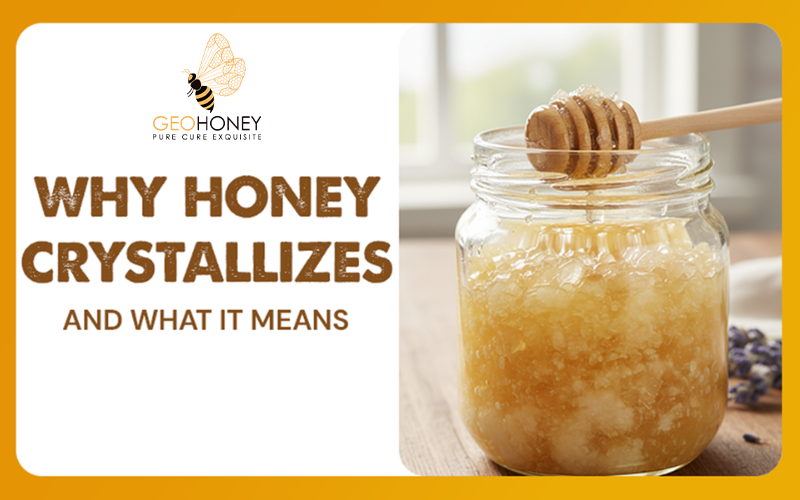
Geohoney
Why Honey Crystallizes and What It Means
The crystallization of honey is a common occurrence that leaves many people confused about its quality, integrity, and safet... read more
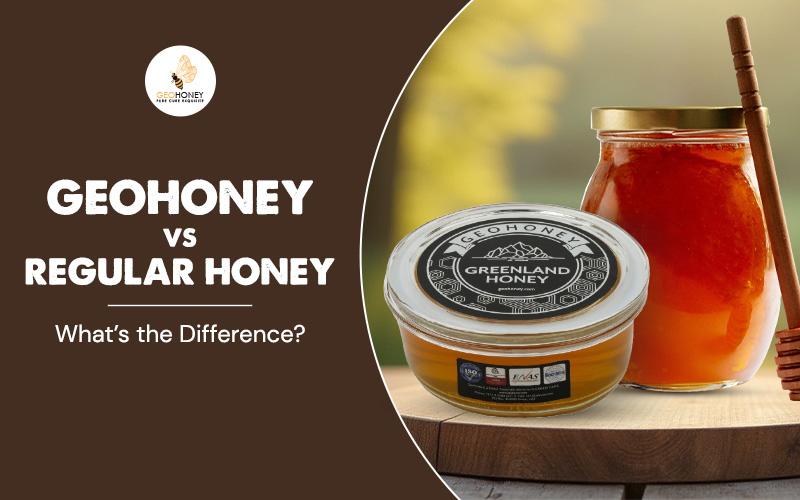
Geohoney
GeoHoney vs Regular Honey – What’s the Difference?
True honey enthusiasts know very well that not all honey is the same in terms of flavor, purity, and quality. The way the ho... read more
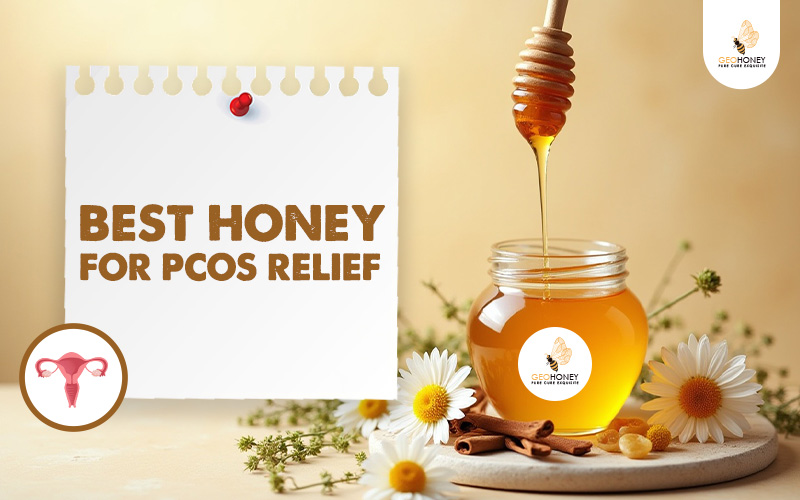
Geohoney
Best honey for PCOS relief
Polycystic Ovary Syndrome or PCOS is a common endocrine, metabolic, and reproductive condition that affects people with ovar... read more

Geohoney
Nature's Unbeatable Technology: What It Takes to Create Artificial Bee
In this era of scientific breakthroughs and engineering excellence, there are very few things that experts are still not abl... read more

Geohoney
A Deep Dive into Spain’s Artisanal Honey Industry
Spanish artisanal honey is a gourmet food ingredient that also possesses exceptional medicinal and healing properties. This... read more


